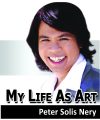 I BARELY made it.
I BARELY made it.
But for the record, Amazon (real name Amazon.com, Inc.) said that my latest book, “At My Father’s Wake”, was published on January 29, 2019.
So, although I didn’t get my author’s copies until February 8, I still consider the book as my January Project.
*
The 14-day online Master Class in Creative Writing with Peter Solis Nery that concluded on Valentine’s Day is, of course, my February Project.
So, again, yeah!
A monthly project for the fifty-year old me in 2019.
That’s a pretty sweet deal.
*
Everything went so fast for me this February.
But, finally, after my Master Class, I took time and read my book.
The book is subtitled: 10 Elegies in 3 Languages.
And it is what it is—ten poems built around my father’s death; that I have written in three languages: English, Filipino, and Hiligaynon.
But that’s not all.
Accompanying the poems are 17 critical essays by some of the most brilliant writers in Philippine literature today.
*
Well, actually, only 12 or 13 are Filipinos.
One of the essayists is African-American.
Another is a Filipina who has long been naturalized in the US.
And one is, or was, a white American by the name of T. Randolph Graydon, my late husband.
*
At My Father’s Wake was a difficult book to make.
My father died in November 2009.
I wrote the first elegies in Hiligaynon in 2011.
By the end of 2012, I have successfully translated the 10 Hiligaynon original into English.
I worked on the Filipino version of the poems in 2013.
And in April 2014, I got the inspiration to publish them all in one volume—with the added value of critical essays from writer-friends of considerable reputation.
*
The critical essays delayed the project, to say the least.
First, there was the process of wooing the writers who were pretty busy with their own writing and (mostly academic) careers.
Think of the months spent waiting for their essays.
But the essays turned out pretty wonderful.
Truly worth all the wait.
And Felino S. Garcia, Jr., 2014 Peter’s Prize medalist for Literary Criticism, thought that a prolegomenon to cover the 16 essays was necessary.
I gave him 90 days to do it.
*
Then, my husband, who submitted one of the essays very early on, passed away in December 2014.
My grief put the book project in the back burner until it was almost forgotten.
Years later, Felino egged me about the book.
He said, the poems were solid and finely crafted, and it would be a shame if they don’t see the light of day.
I worked on the book again.
*
I don’t know if their interest waned because of the publication delay.
Or if the essayists changed their mind about publication.
(I could not blame them.)
But it was more difficult to get the biographical notes from the authors of the critical essays between 2017 and 2018.
(I think I had more difficulty getting their biography than getting the actual essays!)
So, in January this year, I decided to write their biographies in three sentences or less.
I decided that I wanted the entries to look uniform.
*
I submitted the Contributing Writers’ credit page to the authors for correction of factual errors.
When I got no objections or violent reactions, I proceeded to publish.
I did the cover design myself.
The cover picture is a photo I have taken of a bold sculpture near the railway station in Venice, Italy on November 26, 2017.
I’m not sure that the inscription above it is the title of the art piece, but it says: Vobis Gloria Nobis Exemplum.
I think it means, We Copy You Glory.
*
At My Father’s Wake is neither a Valentine’s poem nor a love letter to my father.
In fact, for most readers, the first emotion they read is my resentment towards an absentee father, a father who always leaves, who always has to go.
My poems are not what most people say about the dead.
And I think that’s where their power lies.
That I am able to verbalize the unspeakable.
Because, as always, I am “the” Peter Solis Nery.
And I am glorious./PN

